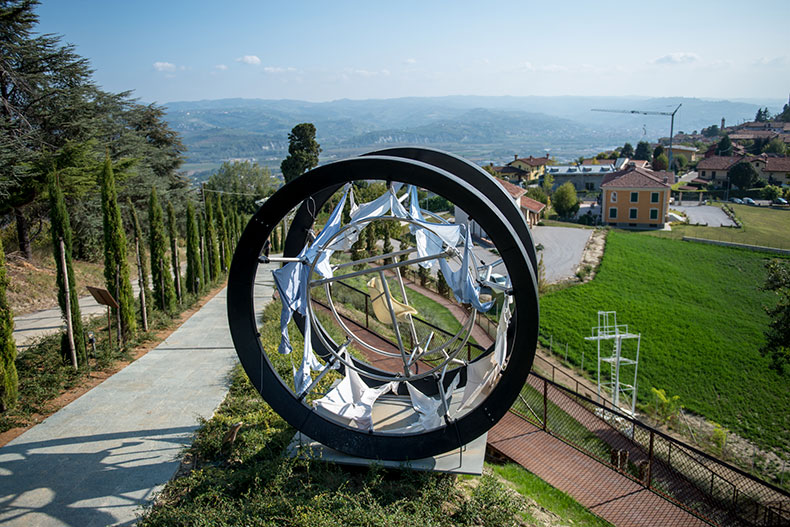From the May 2023 issue of Apollo. Preview and subscribe here.
‘I still have so many things to do. Every day, so much to do,’ says Patrizia Sandretto Re Rebaudengo. The art collector and philanthropist is looking out over the grounds of the Sandretto Re Rebaudengo Art Park on the San Licerio Hill, near the village of Guarene in Piedmont, her brain whirring with ideas for its further development. Established in 2019, the park boasts large-scale sculptures by seven artists, set among vineyards from which the family’s rosé wine StellaRe is produced.
Sandretto Re Rebaudengo began collecting in 1992, when a friend asked her along to visit Anish Kapoor’s studio. Soon after, she acquired his 1000 Names (1983), and before long her collection of contemporary art included works by Sarah Lucas, Damien Hirst, Doug Aitken and Barbara Kruger. She began supporting Maurizio Cattelan in 1994 – before his pranks had earned him renown among Italian public. ‘I started collecting artists of my generation because I was interested in what they thought and did, in the way they saw the world in which we were living,’ Sandretto Re Rebaudengo says. ‘Through them, I learned not to be afraid of what I didn’t understand right away.’
In 1995, she established the Fondazione Sandretto Re Rebaudengo, opening the doors of the family’s 18th-century palazzo in Guarene to the public. The works in her collection were exhibited in a way ‘the public could not see’ in other institutions in Italy. The foundation opened a purpose-built museum in Turin in 2002, to allow more space for a collection that now stands at more than 2,000 works – highlights of which are currently on show at Palazzo Strozzi (until 18 June).
Sandretto Re Rebaudengo says that she did not initially plan to make wine at the park. It is set in the middle of the Langhe, Roero and Monferrato appellations – vineyards which have recently been awarded UNESCO world heritage status. ‘We do not have a commercial interest like the vineyards that surround us,’ Sandretto Re Rebaudengo says. However, the rich soil lends itself temptingly to the cultivation of Nebbiolo. This prized grape originates from Piedmont, and its name derives from the Italian word nebbia (fog), a reference to the thick fog that rolls over these hills. A thick-skinned variety that buds early and ripens late, Nebbiolo needs to be planted to face south-west for maximum heat and sunlight. Nebbiolo has been drunk as a rosé since the 13th century – so with StellaRe, Sandretto Re Rebaudengo is following a long vinicultural tradition. Produced by local winemaker Gianfranco Cordero, the wine is softly pressed, with no more than two hours of skin contact (or maceration – the period when grape skins remain in contact with the juice before fermentation). The secondary aromas particular to rosés develop after one year. Production is small-scale at no more than 1,000 bottles a year; these are drunk at family events, exhibition openings, and occasions hosted by the foundation to celebrate commissions or unveil new works in public spaces in the village.

Amphibian (1999), Carsten Höller
Over the years, Patrizia has invited artists in her collection including Julian Opie and Liam Gillick to design labels for the wine. Underscoring the fact that production of StellaRe is a family affair, the labels for the 2020 vintage depicted Patrizia’s newborn twin granddaughters. ‘The wine is an opportunity to include the whole family in the development of the taste,’ she says. The label for the most recent vintage was designed by Marguerite Humeau, whose sculpture Rise (2021) is installed on top of the San Licerio Hill, alongside the Nebbiolo vines. Made of smelted aluminium, the sculpture is a monumental recreation of the vines’ microscopic male and female flowers, its intertwined forms representing the hermaphroditic nature of the vines themselves. There are several other works in the park which, like wine, are the result of both natural and scientific processes. They include Approximation (Chameleon Through the Looking-Glass) (2022) by Katja Novitskova – an outsized, algorithmically-generated lizard – and one of Wilhelm Mundt’s Trashstones (1991), made, as the title suggests, from reconstituted and resin-cast trash. Two benches sculpted by Mark Handforth, Cypress Reds and Cypress Violets (2021), were made from century-old cypress trees, which fell naturally on the hill. Carsten Höller’s Amphibian (1999) is a vast wheel with a pilot’s seat at the centre and ten hanging shirts for sails. (‘Time to send them to the dry cleaner,’ Sandretto Re Rebaudengo mutters as we walk by.)
The Höller piece is a vehicle that goes nowhere. It asks us instead to picture ourselves soaring across this spectacular landscape – and in fact, all of the works here invite the visitor to reflect upon the surroundings. As Sandretto Re Rebaudengo says: ‘Contemporary art planted in nature is art for all – the way nature is for all.’ The StellaRe wine is just another expression of being rooted in the land.
From the May 2023 issue of Apollo. Preview and subscribe here.














![Masterpiece [Re]discovery 2022. Photo: Ben Fisher Photography, courtesy of Masterpiece London](http://zephr.apollo-magazine.com/wp-content/uploads/2022/07/MPL2022_4263.jpg)
‘Like landscape, his objects seem to breathe’: Gordon Baldwin (1932–2025)